by A. Stoven O’Connor and S. Newman 1(10/09)
Quick Facts…
- Locating a flower bed for spring-planted bulbs requires careful thought about exposure, soil type, and flower height, color and time of flowering.
- If the bed has been used for several seasons with many additions of fertilizer and organic matter, it may be beneficial to have a soil test done on the planting area.
- As soon as the vegetative top of the plant dies down, dig the corms. Remove the withered corm, and store the new corms in a frost-free location over winter.
About Bulbs
The term “bulb” refers to true bulbs and other bulb-like structures such as corms, tubers, tuberous roots and stems, and rhizomes. These structures are natural adaptations that store food to aid in the plant’s survival during unfavorably cold, hot or droughty weather.
Site Selection
Locating a flower bed for spring-planted bulbs requires careful thought about exposure, soil type, and flower height, color and time of flowering. Deciduous trees provide little shade in the spring, but as trees leaf-out, the leaves may create a shade too dense for most bulb and bulb-like plants, except those that are very shade-tolerant. Soil type in most home gardens cannot be changed readily, but soil can be modified with the use of fertilizers and organic materials.
Flower color and size are important to ensure the flower is planted in the right place to showcase the flower’s hues and mature height. In addition, time of bloom may determine flower location to maximize bloom sequence.
Purchasing Bulbs, Corms and Roots
A greater selection of bulbs, corms and roots is available in early rather than late spring. Purchasing prepackaged material allows for convenient shopping. Prepackaged bulbs, corms and roots also help eliminate plant mix-ups. Packaging should allow the consumer to see the bulbs.
Purchasing bulbs, corms and roots from large bins allows the buyer to mix-and-match plant materials on an individual basis. Purchasing plant material in this manner may lead to accidental purchases, but it allows the buyer to individualize a garden. When buying plant material from bins, select only the largest and firmest specimens with no odor suggesting rot. The general idea is the larger the bulb, the better the flower.
Soil Preparation
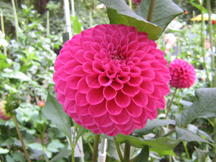 |
| Figure 1: Ball form dahlia. |
If the bed has been used for several seasons with many additions of fertilizer and organic matter, it may be beneficial to have a soil test done on the planting area. Using large amounts of fertilizer and organic matter may lead to high salt levels, hindering plant growth.
If the bed is relatively new, or has not been very productive, work in 1 inch of organic matter. Incorporate fertilizer (such as 5-10-5) to aid plant growth. Colorado soils are typically high in phosphorus and typically do not require any additional phosphorus supplements. However, fertilizers such as 5-10-5 that have higher levels of phosphorus can be beneficial for bulbs. Before applying, follow the suggested fertilizer rate that should be found on the packaging.
Plant Options
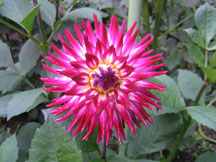 |
| Figure 2: Pink and white dahlia. |
Gladiolus is a popular spring-planted corm, coming in nearly every color, including lime green. Plant the corms 3 inches deep and 6 inches apart in the spring, after danger of frost has passed. During the growing season, the original corm withers and a new corm forms on top of it. The cutting of the flowers does not inhibit the development of the new corm, as long as the leaves are left.
As soon as the vegetative top of the plant dies down, dig the corms. Remove the withered corm, and store the new corms in a frost-free location over winter. Avoid a storage place with high temperatures and low humidity.
Dahlias come in a wide range of flower and plant sizes, and nearly every color, except a true
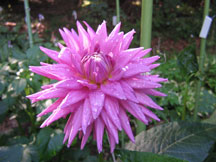 |
| Figure 3: Pink dahlia with water drops. |
blue. Dahlias usually require support because of their height. Provide support by driving a stake into the ground 12 inches deep and 6 inches behind the root at the time of planting. Dahlias do not tolerate frost, so plant the tuberous roots after all frost possibilities have passed. Dahlia flower size can be increased by removal of flower buds from lateral branches. However, this practice may reduce the overall showiness of the plant.
After the vegetation is killed by frost, prune back the stalks to 6 inches. Leave the tuberous roots in the ground for two weeks to harden before digging them. Dig carefully so the tuberous roots do not break away from the clump. If the clump separates, there is a risk of ‘blind roots’, tuberous those that do not produce a shoot because there is not vegetative ‘eyes’. Dry the tuberous roots enough to shake off excess soil, and pack in sawdust, perlite or vermiculite and store in a cool, dry place until spring.
Canna flowers bloom in a wide range of colors—ivory, yellow, scarlet, salmon, rose and
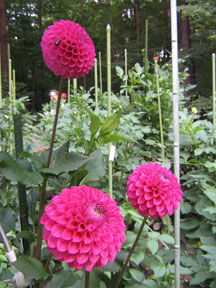 |
| Figure 4: Three-ball form dahlias. |
orange. Foliage can be green, bronze or variegated. Canna plants thrive in contaners, planting beds and also ponds and water gardens. Plant the rhizomes 6 inches deep and 18 inches apart in late spring and after the danger of frost has passed. After frost kills the foliage in fall, dig and store the roots over winter, much the same as dahlias.
Lilies are available in several types and in colors ranging from white and yellow to deep red. While lilies are perennial, some do not survive Colorado’s winters. To test hardiness of a particular lily, dig a portion of the plants and pack the rhizomes in sawdust, perlite or vermiculite. Store the rhizomes in a frost-free location during the winter. Replant the stored lilies in the spring. The plants remaining in the garden should be heavily mulched to avoid winter kill. Plant the lilies to a depth three times the height of the bulb. Easter lilies can also be planted into Colorado gardens with varied success.
Tuberous begonias range in color from white, yellow and orange to deep red. Flowers are usually double and bloom for a long period. Plant the tuberous begonia roots (which may be up to 1 ½ inches in diameter) 4 inches deep in a partially-shaded area. Tuberous begonias do best in soil with high organic matter that is kept relatively moist. After frost, dig the roots from the ground, pack in sawdust, and store under cool, but frost-free conditions for replanting in the spring.
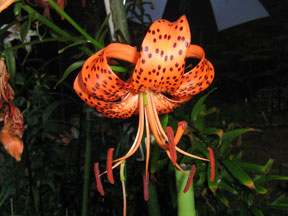 |
| Figure 5: Tiger lily. |
Allium is a member of the onion family, but these plants are very ornamental and showy. Plants vary in height, and flowers can range from two to ten inches in diameter. Dwarf species thrive in rock gardens, and taller species enhance larger gardens. Allium flowers are ball-shaped and consist of many tiny florets in hues of white, yellow and blue. These bulbs make great cut flowers that last for a long period of time; flower heads can also be left to dry on the plant and later cut for dried arrangements. While alliums do not need to be dug from the ground after frost, be sure to mulch the bulbs well to ensure winter survival.
1A. Stoven O’Connor, Larimer County horticulture agent, Colorado State University Extension; and S. E. Newman, professor and greenhouse crop specialist, horticulture and landscape architecture). 3/98. Revised 10/09.
Go to top of this page.





